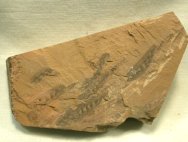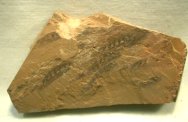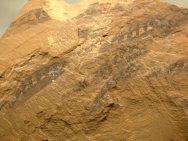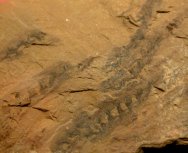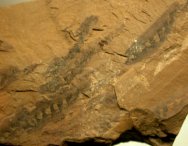Haikouella
lanceolata
Phylum Chordata
Geological
Time: Early Cambrian (~525 million years ago)
Size: Haikouella
are 10 to 17 mm long
Fossil
Site: Chengjiang Maotianshan Shales, Quiongzhusi Section, Yu’anshan
Member, Heilinpu Formation, Haiyi Village, Anning, Kunming County, Yunnan
Province, China
| 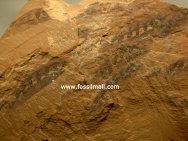 Description:
This exceptional specimen is a multiple (at least seven specimens)
example of Haikouella lanceolata, thought by its describers to be
the earliest craniate-like chordate. This fish-like animal has many
similarities to the contemporaneous Yunnanozoon lividum, but differs
in several aspects: it has a discernible heart, dorsal and ventral
aorta, gill filaments, and a neural chord. For all these reasons,
it was identified by Chen, Huang, and Li in the seminal Nature paper
(Nature 402, 518-522, 02 December 1999) as a chordate. Description:
This exceptional specimen is a multiple (at least seven specimens)
example of Haikouella lanceolata, thought by its describers to be
the earliest craniate-like chordate. This fish-like animal has many
similarities to the contemporaneous Yunnanozoon lividum, but differs
in several aspects: it has a discernible heart, dorsal and ventral
aorta, gill filaments, and a neural chord. For all these reasons,
it was identified by Chen, Huang, and Li in the seminal Nature paper
(Nature 402, 518-522, 02 December 1999) as a chordate.
The
debate rages on, but whatever the outcome, this creature was much
like the ancestor of all the vertebrates. It derives its generic
name from its resemblance to 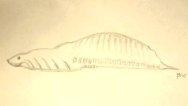 the
modern day lancet Amphioxus. Few examples are ever offered, and
this is the first example with a large number of specimens that
I have seen. Such assemblages have been mentioned in the literature,
and must represent some catastrophe that overcame them en masse.
This is an exceptional museum-quality specimen certain to become
the showcase of any collection of life from the Cambrian Explosion. the
modern day lancet Amphioxus. Few examples are ever offered, and
this is the first example with a large number of specimens that
I have seen. Such assemblages have been mentioned in the literature,
and must represent some catastrophe that overcame them en masse.
This is an exceptional museum-quality specimen certain to become
the showcase of any collection of life from the Cambrian Explosion.
|
|


